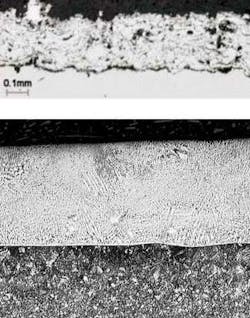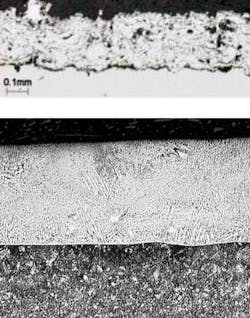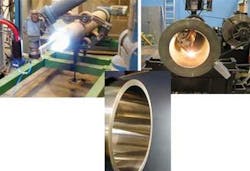Laser fusing–a technique for surface improvement
by Steen Erik Nielsen
For surface coating, laser fusing technology has shown major potential in numerous industrial applications
hat do you do with a broken or worn-out surface on an expensive machinery component to restart your production facility as quickly as possible, at a reasonable cost? Production managers frequently must answer these questions. Do we need to buy a new component? What is the related price and delivery time? And what about repairing, is this a realistic option?
A laser fusing technique developed at FORCE Technology in Denmark has shown to be the answer to the above questions for a number of applications, not only as a repair technique but also as a technique for producing new components.
Laser surface treatment
Surface treatment of industrial components based on the use of a laser beam covers a number of already well described processes, e.g. transformation hardening and laser cladding. The cladding process is typically used for producing a wear- and corrosion-resistant surface related to a certain application or component. The laser based surface treatment techniques are beneficial as they only introduce a limited and well controlled heat input, which makes it possible to produce thin coating thicknesses of high quality while only introducing limited component distortion. These laser based processes are automated processes and cost savings can be high compared with traditional clad surfaces using TIG or MIG/MAG.
The application areas related to the laser surfacing processes are many, including:
- auto, aero, and ship engine components
- food processing equipment
- medical devices and production equipment
- drilling tools and related components in the oil producing industry
- light weight parts
- turbine blades
- metal forming tools
- molds
- tools for printing and paper machining
- cutting tools
Although laser based processes have been known for several years it is only recently that the interest has been growing remarkably due to new and more stable higher power lasers as well as related to more stable auxiliary equipment such as specially designed optics. Also stabilized equipment prices are now making these advanced processes interesting in the competition with alternative techniques.
The laser fusing technique
The laser fusing technique, developed at FORCE Technology, is based on the processing of a material pre-placed on the component surface. This pre-placement procedure is carried out by a suitable thermal spraying technique, such as plasma spraying or High Velocity Oxygen Fuel (HVOF). The coating material is typically present as a fine grained powder during spraying. The powder is melted, while passing an electrical discharge in an inert atmosphere and it is blown at high velocity against the component surface to which it attaches.
The thermally sprayed surface coating is characterized by being porous and mechanically adhered to the surface (see FIGURE 1a). During laser beam melting/fusing the coating is homogenized and thereby sealed/welded to the surface (see FIGURE 1b). In this state the coating is solid with no porosity and with a very low dilution (10–15%) with the parent material. In order to compensate, if necessary, for the dilution or in order to tailor a certain chemical composition, additional alloying elements can be added to the material simply by mixing it into the base powder used during spraying.
In order to melt/fuse the thermally sprayed coating the laser beam typically scans the surface in an overlapping track pattern. Compared to the standard laser cladding process, wider tracks in the range 25–30 mm can be generated, thereby achieving a higher productivity and cost efficient process for the processing of larger component areas.
Different optical means for achieving a required uniform power distribution within the fused track can be considered. Either, traditional high-speed beam scanning techniques or tailored, mirror based, line focusing units may be preferred.
Commonly used wear- and corrosion-resistant coatings are the cobalt-based materials for example, the Stellite types. Also nickel-based very hard coatings including carbides of tungsten carbide for example are of industrial interest. For heat- and corrosion-resistant coatings the Inconel types are commonly preferred. Typically, these materials are self-fluxing alloys with silicon and boron to lower their melting points. Companies like Dolloro Stellite, Pac, Hoeganas, and Colmonoy supply such alloys.
Examples in industrial components
As mentioned the laser fusing technique is an excellent repair technique. FIGURE 2 illustrates a steel component from a power plant, which has been worn out of diameter tolerance by approximately 0.2 mm, enough to discard the component. The 200 mm diameter shaft was cleaned, grit blasted and sprayed with Stellite, and laser fused. The total surface is processed by overlapping tracks performed during a spiral movement. By optimizing the degree of overlapping the surface variation or ‘weave heights’ between tracks is only on the order of 0.05 mm, as seen on the cross section of the surface layer. This means that post machining is limited to the removal of very little material. Typically, a laser fused surface just requires honing or polishing to obtain a mirror polished surface quality. In this way a cost-limited operation has provided an almost new component in a short time.
FIGURE 3 shows the processing of a ship engine piston groove where wear conditions have been a problem over many years. The challenge is to enhance the component lifetime by transferring the wear from the piston groove to the piston ring element, maintaining a reasonable lifetime on this part. The horizontal groove surfaces were sprayed with wear-resistant material followed by the laser fusing process. On larger diameter pistons, 1000 mm in diameter, the groove surfaces were approximately 22 mm wide. The laser treatment was carried out in a one-step operation. A number of pistons have already been long-term tested under real conditions in ship engines.
Surfaces related to food processing equipment have been a hot topic for many years as focus is directed to health and safety issues such as eliminating risks related to migration of unwanted materials into the food. Metallic surfaces that are in direct contact with the food are under consideration.
FIGURE 4 shows the internal spraying and laser fusing of a 1500 mm long, 180 mm ID steel tube. The tube is the central part of a scraped heat exchanger used in the food processing industry. Numerous food products based on oil, milk, butter, margarine, ice cream, ketchup, or sauces are produced in such components. The surface layer is a Stellite alloy selected for both excellent wear and corrosion properties. The surface coating is an improved alternative to electrolytic galvanized chromium coatings, which suffer from combined wear and corrosion stability due to initial microcrack formations in the coating. The laser fused mild steel tube maintains an excellent cooling capacity due to the final surface layer in the range 0.3 mm.
The laser fusing technique is also suitable as a multi layer technique where several layers of the same—or different—coating materials can be fused together. This offers the following advantages; thicker layers can be produced, sandwich layers with different metallurgy can be produced, a tailored metallurgical layer composition can be performed, and repairing of local areas of the surface can be carried out by plasma spraying locally followed by a local laser fusing in several steps.
The industrial examples described are just a limited selection of interesting applications where the laser fusing technology has shown major potential. Many other types of components could have been presented. At FORCE Technology the continuous development of the laser fusing process is ongoing due to a significant interest typically carried out in close collaboration with an industrial company. The laser fusing process is optimized in terms of tailoring the process to the actual component as well as selecting the optimum coating material related to the component operation conditions.
The laser fusing technology has already shown its potential and will without doubt maintain an important role and position among the many already existing industrial surface coating technologies in the future.
Steen Erik Nielsen ([email protected]) is with FORCE Technology (www.force.dk) in Brøndby, Denmark.




